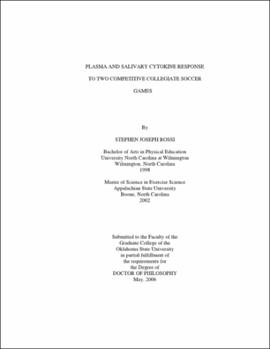| dc.contributor.advisor | Smith, Douglas B. | |
| dc.contributor.author | Rossi, Stephen Joseph | |
| dc.date.accessioned | 2013-11-26T08:34:51Z | |
| dc.date.available | 2013-11-26T08:34:51Z | |
| dc.date.issued | 2006-05 | |
| dc.identifier.uri | https://hdl.handle.net/11244/7554 | |
| dc.description.abstract | PURPOSE: The first purpose of this study was to determine the influence of playing in two competitive collegiate soccer games on cytokine levels in college male soccer players. The second purpose of this study was to compare cytokine levels in plasma and saliva before and after exercise. METHODS: Blood and saliva were collected the morning of game 1, within one hour after game 2, and 15 hours after game 2 from starter's and non starters. Starters played an average of 76 minutes per game and nonstarters played an average of 2.8 minutes per game. Blood was collected into chilled EDTA tubes from an antecubital vein. After rinsing their mouths with water, athletes were instructed to expectorate into sterile tubes for 10 minutes. Saliva volume and time was recorded to calculate salivary cytokine levels adjusted for secretion rate (pg/min). Clarified saliva and plasma samples were analyzed for IL-6, IL-10, TNF-, and IFN-levels using ELISA. RESULTS: TNF- and IL-10 was largely undetectable. Participation in two competitive collegiate soccer games statistically did not influence post exercise levels of plasma and salivary IL-6, IL-10, TNF- , and IFN-; however, pre-exercise plasma levels of IL-6 (24%) and IL-10 (34%) did increase in starters following two competitive soccer games. A non significant increase in salivary levels adjusted for secretion rate of IL-6 (48%), TNF- (120%), and INF- (71%) along with increases in absolute TNF- (87%) and IFN- (33%) was observed following two competitive soccer games. Plasma and salivary cytokine levels before and after exercise were determined to be unrelated. CONCLUSION: The trend for increases in plasma IL-6 and IL-10 and similar tendencies in salivary IL-6, TNF- and INF- may represent an acute systemic and/or oral inflammatory response to two competitive collegiate soccer games which was undetectable with the small sample size in the present study. Further studies are necessary to determine the relationship between plasma and salivary cytokine levels. | |
| dc.format | application/pdf | |
| dc.language | en_US | |
| dc.rights | Copyright is held by the author who has granted the Oklahoma State University Library the non-exclusive right to share this material in its institutional repository. Contact Digital Library Services at lib-dls@okstate.edu or 405-744-9161 for the permission policy on the use, reproduction or distribution of this material. | |
| dc.title | Plasma and salivary cytokine response to two competitive collegiate soccer games | |
| dc.contributor.committeeMember | Edwards, Steven W. | |
| dc.contributor.committeeMember | Kulling, Frank K. | |
| dc.contributor.committeeMember | Breazile, James | |
| osu.filename | Rossi_okstate_0664D_1728 | |
| osu.accesstype | Open Access | |
| dc.type.genre | Dissertation | |
| dc.type.material | Text | |
| thesis.degree.discipline | Health, Leisure and Human Performance | |
| thesis.degree.grantor | Oklahoma State University | |
